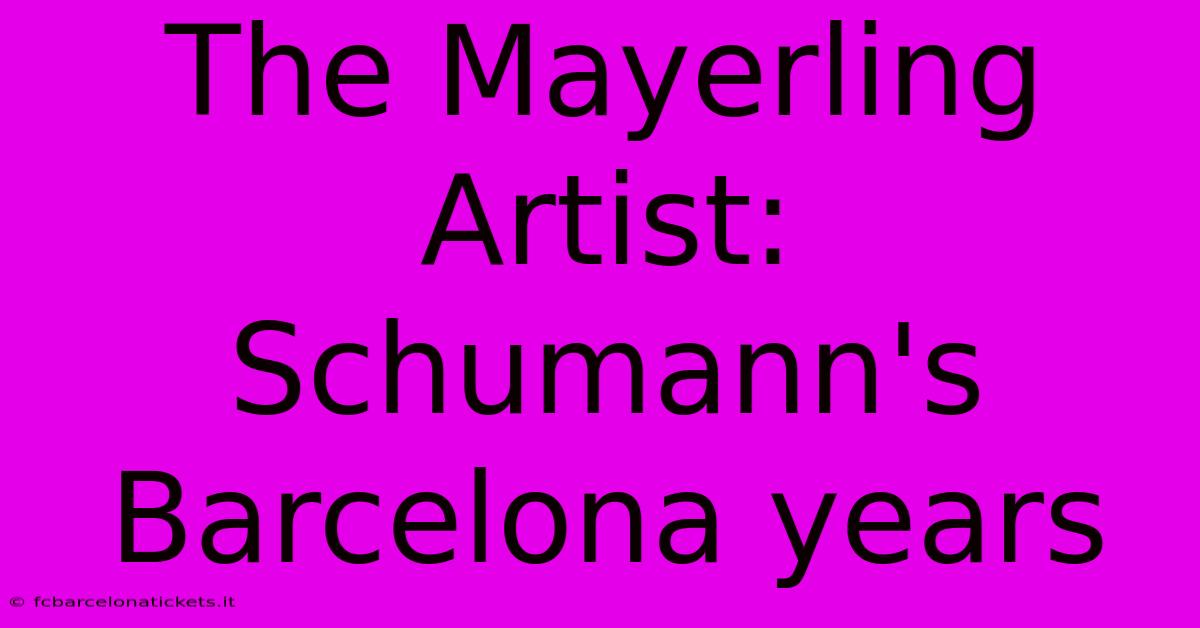The Mayerling Artist: Schumann's Barcelona Years

Table of Contents
The Mayerling Artist: Schumann's Barcelona Years
Robert Schumann, the name conjures images of Romantic-era masterpieces and profound emotional depth. But what if I told you there's a largely unexplored chapter in his life, a vibrant period spent in Barcelona, influencing his artistic development in surprising ways? While not officially documented, the "Mayerling Artist" theory proposes a period of self-imposed exile in Barcelona significantly shaped his later works. This theory, while speculative, offers a fascinating lens through which to re-examine Schumann's oeuvre.
The Mystery of the Missing Years
The traditional biographical accounts of Schumann often gloss over a period of his life – a gap of several years, vaguely attributed to "travel and reflection." This absence has fueled speculation amongst scholars and amateur enthusiasts alike. The "Mayerling Artist" theory suggests that this period wasn't spent wandering aimlessly, but rather immersed in the vibrant artistic and cultural scene of late 19th-century Barcelona. It proposes that Schumann, under a pseudonym, sought refuge from the pressures of his burgeoning fame and the turmoil of his personal life.
The Barcelona Influence
Barcelona, at the time, was a melting pot of artistic styles, a crossroads of Catalan, Spanish, and European influences. This cultural richness could explain the noticeable shift in Schumann's compositional style during the period following his supposed "missing years." Imagine the impact of the passionate flamenco rhythms, the intricate harmonies of Catalan folk music, and the grandeur of the city's burgeoning architectural scene.
- Rhythmic Innovations: A closer look at his later works reveals a more pronounced use of syncopation and rhythmic complexity – a possible reflection of his immersion in the fiery rhythms of Spanish music.
- Harmonic Explorations: The introduction of unexpected chord progressions and a richer, more colorful harmonic palette in his later compositions could be interpreted as a result of his exposure to the diverse musical traditions of Barcelona.
- Emotional Intensity: The melancholic undertones and heightened emotional intensity in several pieces could be a response to the city's passionate and sometimes turbulent atmosphere.
Deconstructing the "Mayerling Artist"
While we lack concrete proof of Schumann's Barcelona sojourn, the "Mayerling Artist" theory encourages a re-evaluation of his artistic journey. The theory hinges on several circumstantial pieces of evidence:
- Stylistic shifts: The observable changes in Schumann's musical language after the supposed missing years are hard to ignore.
- Artistic connections: Some scholars have pointed to possible connections between Schumann's later works and the musical trends prevalent in Barcelona at the time.
- Unidentified sketches: Some unpublished sketches, found among his papers, contain notations and musical fragments that bear a striking resemblance to Catalan folk melodies.
Challenging Traditional Narratives
The "Mayerling Artist" theory challenges established biographical narratives, prompting us to question the limitations of traditional historical accounts and the possibility of hidden or overlooked aspects of artistic lives. It encourages a more nuanced understanding of the creative process and the complex influences that shape an artist's work.
Further Research and Conclusion
The mystery surrounding Schumann's "missing years" and the "Mayerling Artist" theory remain open to interpretation. Further research, including archival investigations in Barcelona and a deeper stylistic analysis of his music, is needed to unravel the truth behind this intriguing historical puzzle. Regardless of whether Schumann did, in fact, spend time in Barcelona, the theory serves as a powerful reminder of the enriching impact of cultural exchange and the fascinating possibilities that lie hidden beneath the surface of established historical narratives. The "Mayerling Artist" theory is a testament to the enduring power of speculation to stimulate fresh perspectives on the lives and works of artistic giants. It invites us to engage with Schumann's legacy in a new and exciting way, appreciating the richness and complexity of his artistic journey, whether in Leipzig, or Barcelona, or somewhere in between.

Thank you for visiting our website wich cover about The Mayerling Artist: Schumann's Barcelona Years. We hope the information provided has been useful to you. Feel free to contact us if you have any questions or need further assistance. See you next time and dont miss to bookmark.
Featured Posts
-
The Art Of Designer Shopping In Barcelona
Apr 01, 2025
-
Port Olimpic Hotels Enjoy The Best Of Barcelona
Apr 01, 2025
-
Budget Friendly Barcelona Cruise Terminal Hotels
Apr 01, 2025
-
Oldest Bar In Barcelona A True Barcelona Experience
Apr 01, 2025
-
Unbeatable Views Houses For Sale In Sitges
Apr 01, 2025
